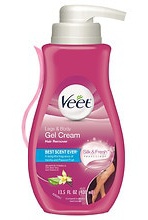
Ingredients overview
Aqua, Cetearyl Alcohol, Paraffinum Liquidum, Potassium Thioglycolate, Calcium Hydroxide, Ceteareth-20, Talc, Glycerin, Parfum, Polyethylene, Sodium Gluconate, Aloe Barbadensis Leaf Juice, Hexyl Cinnamal, Linalool, Citric Acid, Potassium Sorbate, Sodium Benzoate
Read more on how to read an ingredient list >>
Highlights
#alcohol-free
Key Ingredients
Skin-identical ingredientGlycerin
Soothing: Aloe Barbadensis Leaf Juice
Skim through
| Ingredient name | what-it-does | irr., com. | ID-Rating |
|---|---|---|---|
| Aqua | solvent | ||
| Cetearyl Alcohol | emollient, viscosity controlling, emulsifying, surfactant/cleansing | 1, 2 | |
| Paraffinum Liquidum | emollient, solvent | 0, 0-2 | |
| Potassium Thioglycolate | |||
| Calcium Hydroxide | buffering | ||
| Ceteareth-20 | emulsifying, surfactant/cleansing | 3, 2 | |
| Talc | abrasive/scrub | 0, 1 | |
| Glycerin | skin-identical ingredient, moisturizer/humectant | 0, 0 | superstar |
| Parfum | perfuming | icky | |
| Polyethylene | viscosity controlling |
Veet Silk & Fresh Hair Removal Cream, Sensitive SkinIngredients explained
Aqua
Also-called: Water | What-it-does: solvent
Good old water, aka H2O. The most common skincare ingredient of all. You can usually find it right in the very first spot of the ingredient list, meaning it’s the biggest thing out of all the stuff that makes up the product.
It’s mainly a solvent for ingredients that do not like to dissolve in oils but rather in water.
Cetearyl Alcohol
What-it-does: emollient, viscosity controlling, emulsifying, emulsion stabilising, surfactant/cleansing | Irritancy: 1 | Comedogenicity: 2
An extremely common multitasker ingredient that gives your skin a nice soft feel (emollient) and gives body to creams and lotions. It also helps to stabilize oil-water mixes (emulsions), though it does not function as an emulsifier in itself. Its typical use level in most cream type formulas is 2-3%.
It’s a so-called fatty alcohol, a mix of cetyl and stearyl alcohol, other two emollient fatty alcohols. Though chemically speaking, it is alcohol (as in, it has an -OH group in its molecule), its properties are totally different from the properties of low molecular weight or drying alcohols such as denat. alcohol. Fatty alcohols have a long oil-soluble (and thus emollient) tail part that makes them absolutely non-drying and non-irritating and are totally ok for the skin.
Paraffinum Liquidum
Also-called: Mineral Oil | What-it-does: emollient, solvent | Irritancy: 0 | Comedogenicity: 0-2
The famous or maybe rather infamous mineral oil. The clear oily liquid that is the "cheap by-product" of refining crude oil and the one that gets a lot of heat for its poor provenance. It is a very controversial ingredient with pros and cons and plenty of myths around it. So let us see them:
The pros of mineral oil
Trust us, if something is used for more than 100 years in cosmetic products, it has advantages. Chemically speaking, cosmetic grade mineral oil is a complex mixture of highly refined saturated hydrocarbons with C15-50 chain length. It is not merely a "by-product" but rather a specifically isolated part of petroleum that is very pure and inert.
It is a great emollient and moisturizer working mainly by occlusivity. Occlusivity is one of the basic mechanisms of how moisturizers work and it means that mineral oil sits on top of the skin and hinders so-called trans-epidermal water loss, i.e water evaporating out of your skin. When compared to heavy-duty plant oil, extra virgin coconut oil, the two of them were equally efficient and safe as moisturizers in treating xerosis, a skin condition connected to very dry skin.
































